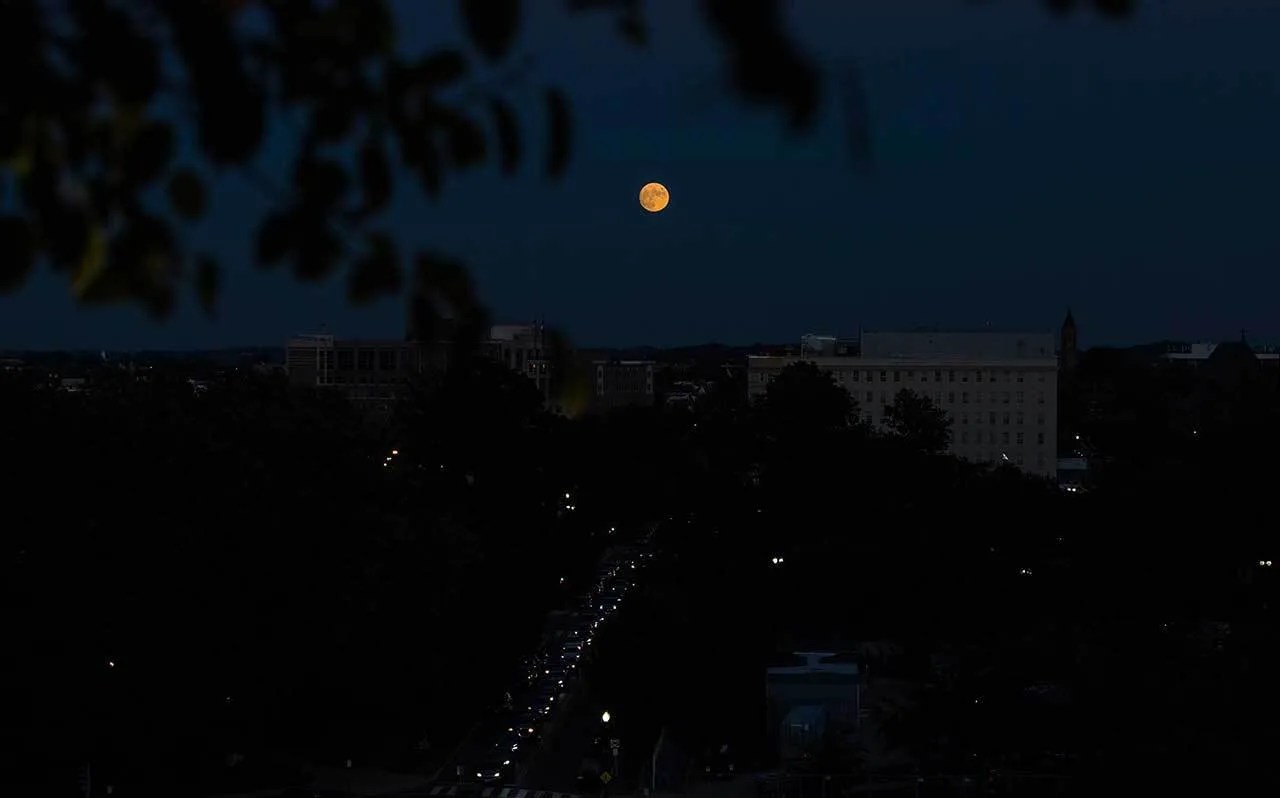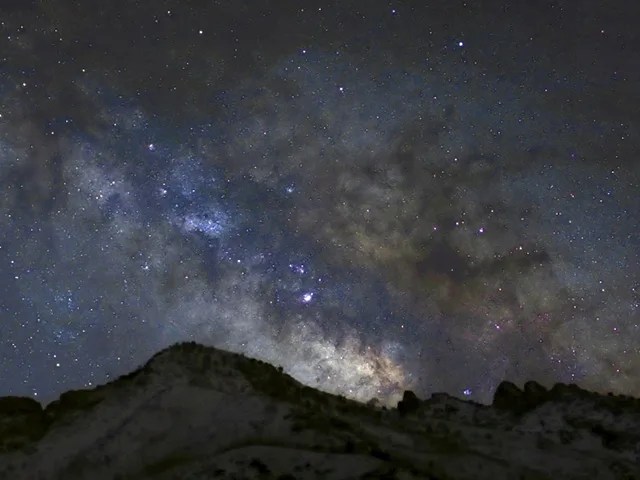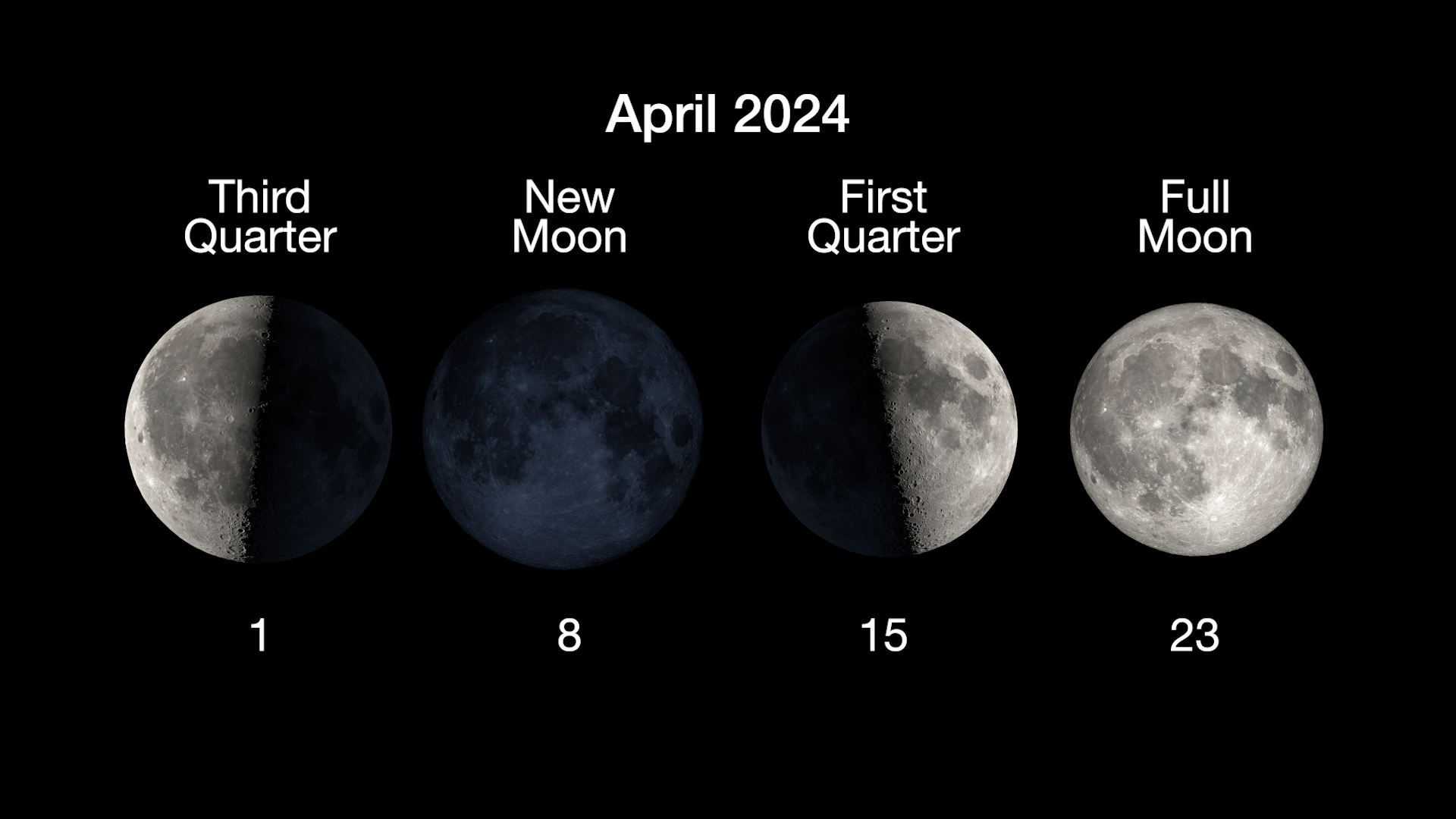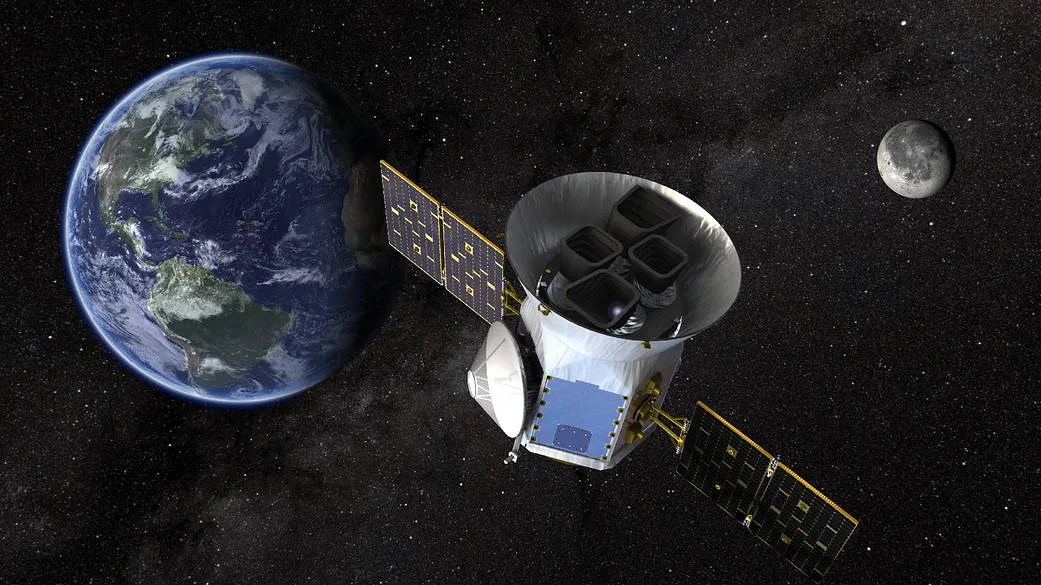15 min read

The next full Moon will be Monday evening, Jan. 17, 2022, appearing opposite the Sun in Earth-based longitude at 6:48 p.m. EST. This will be on Tuesday from West Central Africa and Central European Time Zones eastward across the rest of Africa, Eurasia, and Australia to the International Date Line. The Moon will appear full for about three days around this time, from Sunday evening through Wednesday morning.
The Maine Farmers' Almanac began publishing Native American names for full Moons in the 1930s. Over time, these names have become widely known and used. According to this almanac, as the full Moon in January, this is the Wolf Moon, from the packs of wolves heard howling outside the villages amid the cold and deep snows of winter. Another name is the Ice Moon.
Europeans called this the Moon after Yule, a three-day winter solstice festival in pre-Christian Europe. Another English name for this Moon is the Old Moon.
In the Hindu calendar, this full Moon is Shakambhari Purnima, the last day in the eight-day Shakambari Navratri holiday that celebrates the goddess Shakambhari. In the Purnimanta tradition that ends months on the full Moon day, this full Moon is Paush Purnima, the last day of the Hindu month of Paush. The day after Paush Purnima is the start of the month of Magha, a period of austerity. Bathing in the holy waters of India is an important activity for both Shakambari Navratri and Magha. The Tamil Hindu community celebrates the Thaipusam Festival on this full Moon.
In Myanmar, this full Moon corresponds with the Ananda Pagoda Festival, a week-long celebration of this Buddhist temple built in 1105 A.D. in the city of Bagan. For the Buddhists of Sri Lanka, this is Duruthu Poya, which commemorates Siddhartha Gautama Buddha's first visit to Sri Lanka.
In most lunar and lunisolar calendars, the months change with the new Moon and full Moons fall in the middle of the lunar month. This full Moon is in the middle of the 12th month of the Chinese calendar, Shevat in the Hebrew calendar, and Jumada al-Thani in the Islamic calendar, also known as Jumada al-Akhirah or Jumada al-Akhir. In the Hebrew calendar, the 15th day of Shevat is the holiday Tu BiShvat, which will be observed from sunset on Sunday, Jan. 16, to nightfall on Monday, Jan. 17, 2022. Tu BiShvat is also called "Rosh HaShanah La'Ilanot" (literally "New Year of the Trees"). In contemporary Israel, the day is celebrated as an ecological awareness day, and trees are planted in celebration.
As usual, the wearing of suitably celebratory celestial attire is encouraged in honor of the full Moon. Stay warm, but when the sky is clear, take advantage of these early nightfalls and late sunrises to get out, look up, and share the wonders of the sky!
As winter continues, the daily periods of sunlight continue to lengthen. On Monday, Jan. 17, 2022 – the day of the full Moon – morning twilight will begin at 6:23 a.m., sunrise will be at 7:24 a.m., solar noon will be at 12:18:13 p.m. (when the Sun will reach its maximum altitude of 30.5 degrees), sunset will be at 5:12 p.m., and evening twilight will end at 6:14 p.m. By Wednesday, Feb. 16 – the day of the full Moon after next – morning twilight will begin at 6:00 a.m., sunrise will be at 6:58 a.m., solar noon will be at 12:22:07 p.m. (when the Sun will reach its maximum altitude of 38.97 degrees), sunset will be at 5:47 p.m., and evening twilight will end at 6:45 p.m.
On the evening of Mon, Jan. 17, 2022 – the day of the full Moon – as evening twilight ends at 6:14 p.m. EST, the brightest planet visible will be Jupiter, appearing 20 degrees above the southwestern horizon. The other visible planet will be Saturn, appearing to the lower right of Jupiter at only 2 degrees above the horizon and setting 15 minutes later. The planet Mercury will have already set about two minutes before evening twilight ends, but it may be visible earlier in the twilight before it sets, appearing fainter than Saturn. The full Moon will appear about 13 degrees above the east-northeastern horizon near the bright star Pollux. No particularly bright star will appear overhead, with Capella the closest at 53 degrees above the east-northeastern horizon. Although we see Capella as a single star (the 6th brightest in our night sky), it is actually four stars – two pairs of stars orbiting each other. Capella is about 43 light-years from us.
As the lunar cycle progresses, Jupiter, Saturn, Mercury, and the background of stars will appear to shift westward each evening, although it is actually the Earth that is moving around the Sun toward the east. Jan. 19 will be the last evening that Saturn will appear above the horizon as evening twilight ends. Jan. 20 will be the last evening that Mercury will appear above the horizon 30 minutes after sunset (approximately when it will cease being visible in the glow of dusk). The waxing Moon will appear near Jupiter on Feb. 2 and near the bright stars Aldebaran on Feb. 9 and Pollux on Feb. 13.
By the evening of Wednesday, Feb. 16, 2022 – the day of the full Moon after next – as evening twilight ends at 6:45 p.m. EST, the bright planet Jupiter will be setting on the western horizon. The full Moon will appear about 9 degrees above the east-northeastern horizon near the bright star Regulus. The bright star appearing nearest to overhead will be Capella at 78 degrees above the northeastern horizon.
On the morning of Jan. 17, 2022 – the day of the full Moon – as morning twilight begins at 6:23 a.m. EST, the bright planet Venus will appear 2 degrees above the east-southeastern horizon and the fainter planet Mars will appear 10 degrees above the southeastern horizon. The full Moon will appear low on the west-northwestern horizon near the bright star Pollux. The bright star appearing closest to overhead will be Arcturus at 70 degrees above the southern horizon. Arcturus is the 4th brightest star in our night sky and is 36.7 light-years from us. While it has about the same mass as our Sun, it is about 2.6 billion years older and has used up its core hydrogen, becoming a red giant about 25 times the size and 170 times the brightness of our Sun. Also nearly overhead toward the North will be the constellation Ursa Major, also known as the Big Dipper.
As the lunar cycle progresses, Venus, Mars, and the background of stars will appear to shift westward each morning, with Mars moving more slowly. The waning Moon will appear near the bright star Regulus on Jan. 20, Spica on Jan. 24, Antares on Jan. 28, and the planet Mars on Jan. 29. The planet Mercury will begin rising earlier than 30 minutes before sunrise after Jan. 25 (approximately when it will start being visible in the glow of dawn). By Jan. 31 Mercury will start appearing above the east-southeastern horizon as morning twilight begins and by Feb. 9 and 10 it will reach its highest above the horizon at the start of morning twilight (3.7 degrees), after which it will start shifting back toward the horizon again.
By the morning of Feb. 16, 2022 (the day of the full Moon after next), as morning twilight begins at 6:00 a.m. EST, the bright planet Venus will appear 15 degrees above the southeastern horizon, second in brightness will be Mercury appearing 3 degrees above the east-southeastern horizon, and Mars will appear to the lower right of Venus at 10 degrees above the southeastern horizon. The full Moon will appear low on the west-northwestern horizon near the bright star Regulus. The bright star appearing closest to overhead will be Arcturus at 63 degrees above the southwestern horizon.
Here is a more detailed, day-by-day listing of celestial events between now and the full Moon after next. Please note that the times and angles are based on the location of NASA Headquarters in Washington, D.C., and some of these details may differ for your location.
On Wednesday evening, Jan. 12, 2022, if you have a clear view of the west-southwestern horizon, you might be able to see the planets Mercury and Saturn appearing 3.3 degrees apart. Mercury will be 4 degrees above the horizon as evening twilight ends at 6:09 p.m. EST with Saturn to the upper left. Mercury will set first 24 minutes later at 6:33 p.m. The pair will appear near each other for several evenings around this time, but Wednesday evening is when they will appear at their closest.
Thursday evening into Friday morning, Jan. 13 to 14, 2022, the bright star Aldebaran will appear near the waxing gibbous Moon. Aldebaran will be about 6 degrees to the lower right of the Moon as evening twilight ends on Thursday night at 6:10 p.m. EST. Aldebaran will have shifted to appear about 7 degrees below the Moon as the Moon reaches its highest in the sky for the night (at 9:12 p.m.). Aldebaran will set on the west-northwestern horizon on Friday morning at 4 a.m.
Friday morning, Jan. 14, 2022, at 4:27 a.m. EST, the Moon will be at apogee, its farthest from the Earth for this orbit.
As mentioned above, the next full Moon will be on Monday evening, Jan. 17, 2022, at 6:48 p.m. EST. The Moon will appear full for about three days around this time, from Sunday evening through Wednesday morning. The bright star appearing near the full Moon will be Pollux, the brighter of the twins in the constellation Gemini.
Wednesday, Jan. 19, 2022, will be the last evening that the planet Saturn will appear above the horizon as evening twilight ends, although it may be visible before twilight ends for a few more nights. Saturn will pass on the far side of the Sun as seen from Earth in early February.
On Wednesday night into Thursday morning, Jan. 19 to 20, 2022, the waning gibbous Moon will appear near the bright star Regulus. Regulus will rise below the Moon on the east-northeastern horizon on Wednesday evening at about 7:40 p.m. EST. The Moon will reach its highest in the sky for the night on Thursday morning at 2:11 a.m., with Regulus about 6 degrees below the Moon. Regulus will appear about 5 degrees to the lower left of the Moon by the time morning twilight begins at 6:21 a.m.
Dusk on Thursday, Jan. 20, 2022, will be the last evening that the planet Mercury will appear above the horizon 30 minutes after sunset (approximately when it will cease being visible in the glow of dusk).
Thursday night, as the Moon rises above the east-northeastern horizon at 7:58 p.m. EST, the bright star Regulus will appear about 8 degrees to the upper right of the Moon. The pair will separate as the evening progresses.
On Sunday morning, Jan. 23, 2022, the planet Mercury will be passing between the Earth and the Sun as seen from the Earth, called inferior conjunction. Mercury will be shifting from the evening sky to the morning sky and will begin emerging from the glow of dawn in a few days (depending upon viewing conditions).
On Monday morning, Jan. 24, 2022, the bright star Spica will appear near the waning gibbous Moon. Spica will be about 9 degrees below the Moon as Spica rises in the east-southeast just before midnight on Sunday night. The Moon will reach its highest in the sky for the night on Monday morning at 5:12 a.m. EST with Spica about 7 degrees below the Moon. Morning twilight will begin about an hour later at 6:19 a.m. EST.
On Tuesday morning, Jan. 25, 2022, the planet Mercury will begin rising more than 30 minutes before sunrise (approximately when it will start being visible in the glow of dawn). The waning Moon will appear half-full as it reaches its last quarter at 8:41 a.m. EST.
On Friday morning, Jan. 28, 2022, the bright star Antares will appear about 7 degrees to the upper right of the waning crescent Moon. The Moon will rise above the east-southeastern horizon after Antares at 3:58 a.m. EST, and the pair will appear to separate until Antares is lost in the glow of dawn (with morning twilight beginning around 6:17 AM).
On Saturday morning, Jan. 29, 2022, the planet Mars will appear about 4 degrees to the left of the waning crescent Moon. The Moon will rise above the southeastern horizon at 5:10 a.m. EST, and will be about 9 degrees above the horizon as morning twilight begins at 6:16 a.m.
Early Sunday morning, Jan. 30, 2022, at 2:10 a.m. EST, the Moon will be at perigee, its closest to the Earth for this orbit.
Monday morning, Jan. 31, 2022, will be the first morning that the planet Mercury will appear above the east-southeastern horizon before morning twilight begins at 6:15 a.m. EST.
Early Tuesday morning, Feb. 1, 2022, at 12:46 a.m. EST, will be the new Moon, when the Moon passes between the Earth and the Sun and will not be visible from the Earth.
The day of or the day after the New Moon marks the start of the new month for most lunisolar calendars. Lunisolar calendars use the cycles of the Moon for the months, but occasionally add an extra or "leap" month to keep the calendar tied to the solar seasons. In the Hebrew calendar, the days start with sunset. Sundown on Monday, Jan. 31, 2022, will be the start of the first Adar or Adar I, the "leap" month for Hebrew Year 5782, and the next month will be the second Adar.
The first month of the Chinese calendar will start on Tuesday, Feb.1, 2022 (at midnight in China's time zone, which is 13 hours ahead of EST), making this the Chinese New Year's Day and the start of the Year of the Tiger. Chinese New Year (and related festivals throughout much of Asia and in places with significant Chinese populations) celebrates the end of winter, and the start of spring. Festivities will start on the eve of Chinese New Year (Monday, Jan. 31) and will continue until the Lantern Festival on the 15th day of the first lunar month (Tuesday, Feb. 15).
In the Islamic calendar, the months traditionally start with the first sighting of the waxing crescent Moon. Many Muslim communities now follow the Umm al-Qura Calendar of Saudi Arabia, which uses astronomical calculations to predict the start of the months. Using this calendar, the seventh month of the year, Rajab, is expected to begin at sunset on Tuesday, Feb. 1, 2022. Rajab is one of the four sacred months in which warfare and fighting are forbidden.
On Wednesday evening, Feb. 2, 2022, the bright planet Jupiter will appear about 5 degrees to the upper right of the waxing crescent Moon. As evening twilight ends at 6:31 p.m. EST, the Moon will appear about 7 degrees above the west-southwestern horizon. The Moon will set about 45 minutes later at 7:17 p.m.
On Friday afternoon, Feb. 4, 2022, the planet Saturn will be passing on the far side of the Sun as seen from the Earth, called conjunction. Because Saturn orbits outside of the orbit of Earth it will be shifting from the evening sky to the morning sky and will begin emerging from the glow of dawn on the east-southeastern horizon around Feb. 20 (depending upon viewing conditions).
On Tuesday morning, Feb. 8, 2022, the Moon will appear half-full as it reaches its first quarter at 8:50 a.m. EST.
On the mornings of Wednesday and Thursday, Feb. 9 and 10, 2022, the planet Mercury will appear at its highest above the east-southeastern horizon (3.7 degrees) as morning twilight begins (at 6:07 and 6:06 a.m. EST, respectively), after which Mercury will begin shifting back toward the horizon each morning.
Wednesday evening into early Thursday morning, Feb. 9 and 10, 2022, the bright star Aldebaran will appear below the waxing gibbous Moon. Aldebaran will be about 8 degrees below the Moon as evening twilight ends at 6:38 p.m. EST, and the Moon will reach its highest in the sky for the night about 40 minutes later at 7:07 p.m. when Aldebaran will appear to the lower left of the Moon. Aldebaran will set first on the west-northwestern horizon a little over 7 hours later on Thursday morning at 2:22 a.m.
Thursday night at 9:38 p.m. EST, the Moon will be at apogee, its farthest from the Earth for this orbit.
Sunday night into Monday morning, Feb. 13 to 14, 2022, the bright star Pollux (the brighter of the twin stars in the constellation Gemini) will appear near the waxing gibbous Moon. Pollux will appear about 3 degrees to the upper left of the Moon as evening twilight ends at 6:42 p.m. EST. The Moon will reach its highest in the sky a little less than 4 hours later at 10:27 p.m. with Pollux about 4 degrees to the upper right of the Moon. Pollux will set first below the northwestern horizon about 7 degrees to the right of the Moon around the time morning twilight begins at 6:02 a.m.
The full Moon after next will be on Wednesday, Feb. 16, 2022, at 11:57 a.m. EST. The Moon will appear full for about three days around this time, from about midnight Tuesday morning to about midnight Thursday night. The bright star appearing near the full Moon will be Regulus.
Skywatching tips, guides, and FAQs.








